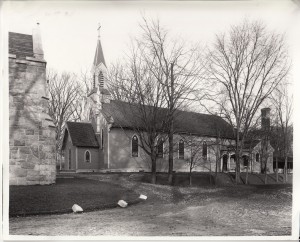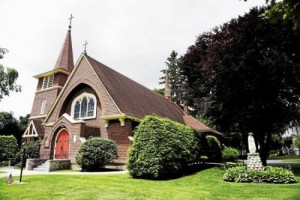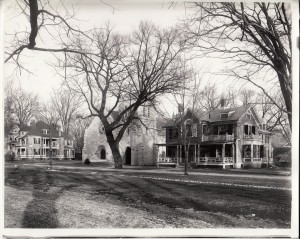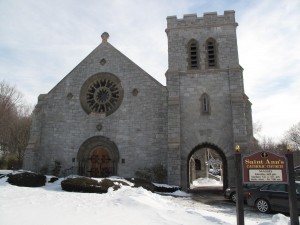St. Ann’s Catholic Church in Lenox
Today (2016), St. Ann’s is the largest church in Lenox. But Catholic settlers were few and far between in the early days. John Grace who bought land in north Lenox in 1783 is noted as a Catholic. It’s not clear how we know that but perhaps it is because he applied for exemption from the requirement to pay tax (required in those days) toward support of the Congregational church.
An early Catholic of some notoriety, Patrick Plunkett, worked as gardener for the important town founder and county judge, William Walker. He came to Lenox in 1794 when it was experiencing one of its early building booms. As many immigrants who came later would do, he rapidly moved from personal service to the wealthy to being a contractor. He and his wife Mary Robinson Plunkett provided a launch point for other Irish immigrants who started coming to Lenox and his descendants became major manufacturers in Pittsfield, Adams and Lee. There were no nearby Catholic churches and the Plunkers and other loyal Catholics went to Albany or Hudson for religious services. He bought Levi Glezen’s home in 1830 and died in 1839.
Irish Emigrants and the Catholic Church in Lenox
The pace of Irish immigration picked up through the 1840’s – both because of conditions in Ireland and because of work opportunities in Lenox. The Housatonic River drove sawmills and iron furnaces and ore had been discovered under Lenox and Richmond. Servants were needed to take care of the visitors to Lenox courts (now the county seat) as well as laborers to staff the mills and mines.
By 1846 there were 12 or more Catholic families in town and they convinced Father Brady of Cabotsville (Chicopee) to come to Lenox to say Mass. Services were held in the home of William Gorman who lived on what is now Housatonic Street (near Orbed Road). Father Brady or Father O’Cavannagh (from Pittsfield) continued to visit and hold Mass in Gorman’s home or in the home of his daughter Bridget Gorman Mahanna.
On the Sundays when no priest came to Lenox, the Catholic flock went to Lee, Great Barrington or other towns where Mass was being said.
Father Cuddihy organized Lenox as a mission for Pittsfield in 1852 and said Mass as frequently as he could in Mrs. Mahanna’s home, the Academy building, or the town hall (old courthouse).
By 1856, services got closer with Lee being made a parish with Lenox now a mission for Lee. From that time, Lenox Catholics worshiped once a month in Lenox at the town hall. In 1864, Father Brennan, the Lee priest, started holding Sunday School in the town hall. Wealthy convert Grace Sedgwick had already started conducting catechism classes in her home.
First Catholic Church on Main Street – 1870
The first step toward having a Lenox domicile – even if still a mission of Lee rather than its own parish – was to purchase property. With the assistance of Miss Sedgwick, Father Brennan purchased property on Walker that was later exchanged for the current Main St. property.

Through the generosity of the town’s Catholics and others, Lenox finally had its own Catholic church in 1870.
In 1885, the northern part of town was annexed to the parish of Lenox so St. Ann’s now covered the entire town.
In 1891 St. Ann’s became a parish with Father William J. Dower as the first resident pastor. Father Dower was active in town activities and fund raising for the parish.
Lenox Catholic Cemetery
Near the Gorman cottage where early services had been held, a large tract was purchased from the Washburn estate in 1888. William Mahanna, Bridget’s grandson, assisted in obtaining the property and having it set up as a cemetery.
New Building in Lenox Dale to Accommodate Growing Parish

By 1903 the congregation had grown to 1100 (1500 in summer). The next priest, Father William F. Grace went to work on a church at Lenox Dale. St. Vincent de Paul was dedicated in 1904 and became an independent parish in 1912.

In 1907 the frontage of the St. Ann Main St. location was expanded by purchasing the Willows, a summer rental property.
In 1912 Father Grace started using the Willows as a rectory. (Later the property at 134 Main became the rectory).
On August 26 that same year, the new St. Ann’s, standing today, was completed.

